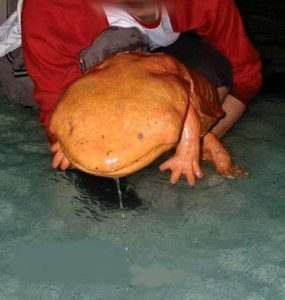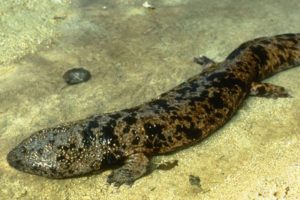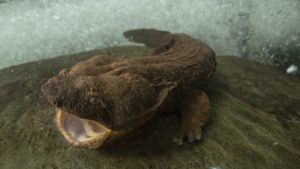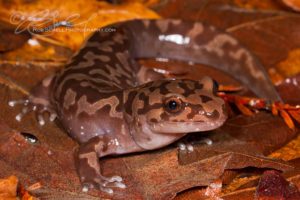Podcast: Play in new window | Download (Duration: 15:59 — 14.4MB)
In episode 14, we discuss the big three of giant salamanders–and some possible mystery relatives.
The Chinese giant salamander. An orange one. Enormous. Mostly harmless. Just wants to eat a snail.

The Japanese giant salamander:

The HELLBENDER reverb reverb reverb

The Pacific giant salamander. Not as giant but has an angry:

Show transcript:
Welcome to Strange Animals Podcast. I’m your host, Kate Shaw.
This week we’re looking at giant salamanders. Yup.
Salamanders are amphibians. Think “wet lizards” or “skinny frogs with tails.” A lot of people think snakes are slimy, but they’re not. Snakes are reptiles and their scales are satiny smooth and dry. Amphibians don’t have scales and they do have slimy skin, which they need to keep moist.
Some salamanders are completely aquatic but most live at least part of their lives on land, usually in wet areas. When I was a kid, I used to like turning over rocks in the creek behind our house, because frequently I’d find a salamander underneath. I wouldn’t catch it, just look at it, which is what you should do if you find a salamander—partly because it’s not good to disturb a wild animal that’s just trying to live its life, and partly because salamanders secrete toxins through their skins. The toxins won’t kill you, but if you get any in your eyes or mouth you could be in for some unpleasant symptoms.
There are two species of salamander known to be venomous, in a way, but they don’t inject venom with special fangs. When the sharp-ribbed salamander is attacked, it pushes its pointed ribs through tubercules along its sides. The tubercules secrete toxins that coat the rib points, which then pierce right through the salamander’s skin and into its attacker.
There are hundreds of salamander species throughout the world, some of them tiny, most of them a few inches long [about 5 or 6 cm], but there are three that are much bigger than that. The biggest is the Chinese giant salamander. The biggest ever found was just shy of six feet long [two meters]. Six feet long! The closely related Japanese giant salamander is almost as big, some five feet long [1.5 meters].
There’s a third giant salamander right here in the southeastern United States where I live, and while at two and a half feet long [76 cm] it’s not nearly as long as its cousins, it has a much better name. The Chinese giant salamander’s local name is infant fish, because some of the sounds it makes remind people of babies crying, which is creepy as heck. The Japanese giant salamander is called the giant pepper fish, because when it’s disturbed it secretes a whitish mucus that smells like pepper. But the North American giant salamander? We call that thing the H E L L B E N D E R.
I did try to find audio of the Chinese giant salamander crying. I had no luck, which is probably a good thing actually, because it’s a distress call. I did find this awesome audio of a Pacific giant salamander. Despite the name giant in its name, it’s not very big compared to the other giants, only about a foot long at most [30 cm], but it does have a cute vocalization.
[Pacific giant salamander call]
(He’s so mad.)
The Chinese and Japanese giant salamanders are so closely related that they readily interbreed. We know that because some fool decided to introduce some Chinese salamanders into streams in Japan. Hellbenders are not as closely related to the Asian salamanders.
All three of the giant salamanders are endangered, mostly due to habitat loss and pollution. They like clean, swift-moving mountain streams with rocks of just the right size—not too big, not too small. But the Chinese salamanders are also considered a delicacy, so they’ve been overhunted as well. Poaching is a major issue, ironically to stock salamander farms. The adults breed readily in captivity, but farmers haven’t had much success getting captive-born individuals to breed, so they continue to capture adults from the wild.
Giant salamanders are fully aquatic, although they can and do get out of the water occasionally for short periods. All three have thick folds of skin along their sides, which increases their surface area, and that’s important because they breathe through their skins. Larval giant salamanders have gills, but when they mature they lose those gills. The hellbender may retain a gill slit but it no longer functions.
While giant salamanders do have a single lung, they don’t use it to breathe. They use it for buoyancy. They like fast-moving water because it’s well oxygenated. A salamander will also rock gently to increase the amount of water moving over its skin, and male salamanders will wave fresh water over their eggs. Males dig and defend the nests. In Japan, they’re called den-masters.
Giant salamanders are flattish in shape with broad bodies and wide heads. Their feet have stubby little toes. They eat fish, snails, crawdads, worms, insects, small mammals, snakes, frogs—basically anything they can catch. They snap up prey fast, sucking it in my creating a vacuum when they open their huge mouths. They range in color from slate gray to black to brownish with dapples. Occasionally an orangish or pink individual is discovered.
All the giant salamanders have poor eyesight, but they have a good sense of smell. In addition, the Chinese and Japanese giant salamanders have sensory cells along the sides of their bodies that detect vibrations in the water. The hellbender doesn’t have that kind of sensory cells as far as I’ve been able to find out, but it does have light sensitive cells on its body, especially the tail. This lets it know when its tail is safely hidden, rather than sticking out from under a rock.
Larval hellbenders look a lot like another large salamander in the area, called the mudpuppy or water dog. The mudpuppy can grow a bit over a foot in length [31 cm], but it retains its gills throughout its life. Don’t be fooled by fake hellbenders.
So those are the three giant salamanders in the world, but there are rumors of other giants in the streams and rivers of California. In the 1920s, an attorney named Frank L. Griffith, who was hunting in the area, spotted five salamanders in a lake in the Trinity Alps in northern California. The salamanders ranged in size between five and nine feet long [1.5 and 2.7 m]. He hooked one with a line, but he wasn’t strong enough to land it and it escaped. In the 1940s, animal handler Vern Harden claimed he’d seen eight-foot [2.4 m] salamanders in Hubbard Lake.
Thomas L. Rodgers, a biologist at Chico State College, conducted four expeditions to the Trinity Alps in 1948 in search of the giant. The expeditions didn’t find anything bigger than foot-long [30 cm] Pacific giant salamanders, but Rodgers suggested that the Trinity Alps giant might be a subspecies of the Pacific giant that grows to an enormous size, or might be a cryptobranchid like the eastern hellbender or the Asian giant salamanders.
In 1951, herpetologist George S. Myers published a paper about his own sighting. He said that in 1939 he was contacted by a commercial fisherman who had dredged up a two and a half foot [76 m] salamander in a catfish net from the Sacramento River. Myers described the salamander as dark brown with dull yellow spots, and said that it resembled the Chinese and Japanese giant salamanders but appeared to be a different species.
In 1960, Bigfoot hunter Tom Slick convinced an expedition looking for Bigfoot to hunt for the salamander too, with no luck. Also in 1960, Tom Rogers mounted another expedition, this time with some zoology professors and ten interested laymen. Again, they only found the foot-long Pacific giant salamander.
Rodgers decided he was wrong about the existence of a new giant salamander, and in 1962 denounced the previous sightings as misidentifications and hoaxes. More recently, a 1997 expedition led by Japanese-American writer Kyle Mizokami likewise came up with no sightings.
It’s not out of the realm of possibility that a giant salamander lives in the Trinity Alps and just hasn’t been found. It’s the right climate with the right conditions. And new salamanders are occasionally discovered in the United States. In 2009, a new species of lungless salamander was discovered in the Appalachian foothills. Yeah, that’s near where I live!
But that one is barely an inch long [2.5 cm]. It should be a little easier to spot a salamander longer than a grown man is tall, not to mention that two of the Trinity Alps giant salamander sightings report salamanders in lakes. If they’re cryptobranchids, they need running water to survive—streams or shallow rivers.
And as for the third sightings, the one where George Myers actually got a first-hand look at a giant salamander caught in the Sacramento River, there’s more to the story. Tom Rogers, the biologist who led five different expeditions to search for the salamander, also saw the Sacramento specimen. The fisherman had managed to keep it alive in his bathtub. Rogers identified it as a Chinese giant salamander, and in fact it turned out to be a lost pet named Benny that had escaped while being taken to Stockton Harbor by steamer.
If these were the only sightings of giant salamanders in North America that aren’t hellbenders, it wouldn’t be looking good for them. But we’re definitely not done. In his blog, zoologist Karl Shuker reports hearing from a woman who sighted a huge salamander in Redwood Park in Arcata, California in 2005. She described it as several feet long [1 meter] with a rounded head instead of flat like known giant salamanders, no skin folds along its sides, and reddish markings. She spotted it walking on land after a rain. Shuker suggests she might have seen an unusually large coastal giant salamander, which can reach almost a foot and a half in length [45 cm] and which she said her salamander resembled in many respects. Remember that Pacific giant salamander sound I played earlier? The coastal giant salamander is a type of Pacific giant salamander.
California isn’t the only state with a mystery giant salamander, though. Three other states have interesting reports, and all of them are pink.
Pink salamanders actually aren’t all that uncommon. Alibinism in salamanders is well known and not rare, and they frequently look pink due to blood vessels visible through their unpigmented skin.
In the early 1960s, biology student Mary Lou Richardson was bowhunting along Florida’s St. Johns River with her father and a friend. All three saw an animal the size of a donkey with a big flat head and a small neck. Other tourists saw the animal that same day, and local fishermen were familiar with it going back to 1955. It’s not clear from the description if the animal was a salamander or something else.
Then, on May 10, 1975, five people on a fishing trip on the St. Johns River saw a weird pink animal’s head and neck on the water. It was only 20 feet [6 m] from their boat and watched them for about eight seconds before diving again. One witness, Dorothy Abram, described it as having a head the size of a human’s with small horns like a snail’s. Another witness, Brenda Langley, also noted it had “this little jagged thing going down its back.” Presumably she meant serrations of some kind. The party also said the animal had large dark eyes and gills or gill-like flaps on either side of its head.
In Ohio, the first white settlers near Scippo Creek, called Catlick Creek Valley at the time, discovered what they called giant pink lizards living in the area. They were three to seven feet long [1 to 2.1 m] and lived in and around water. They also had moose-like horns, pretty big ones apparently. But after a drought followed by a devastating wildfire, by 1820 the pink lizards seemed to have died out.
And in South Carolina around 1928, nature writer Herbert Sass and his wife were boating on Goose Creek near Charleston when Sass saw something big under the water. He lifted it with an oar and although it almost immediately slipped back into the water, they were able to get a good look. Their description sounds a lot like a hellbender or other giant salamander, in this case as thick around as a man’s thigh and five or six feet long [1.5 to 2 m]. It was salmon pink and orange.
The St. Johns River monster might have been a manatee. The area where it was spotted is a manatee refuge and manatees have been responsible for other mystery animal sightings in the past. Then again, manatees don’t have snail horns, serrated backs, or gills, and known giant salamanders don’t either. It’s important to note too that in the 1975 sighting of the monster, dubbed Pinky because of course it was, witnesses described it as being dinosaur-like and said the skin appeared to be stretched so tightly over its head that the shape of the bones were visible. That doesn’t sound like either a manatee or a salamander, more like a reptile of some kind.
The Ohio and South Carolina sightings are much more interesting in regards to giant salamander sightings. Ohio is historically part of the hellbender’s range, and a population of hellbenders have recently been reintroduced there. Shuker suggests the horns described on the so-called pink lizards might actually have been branching external gills seen underwater. Most species of salamander lose their gills after they grow out of their larval stage, but not all, including mudpuppies. Mudpuppies aren’t as big as hellbenders, but that doesn’t mean there wasn’t once a variety that grew much larger.
South Carolina is also part of the hellbender’s range, and Sass’s pink and orange animal might very well have been an exceptional large specimen. Sass himself called it a hellbender.
Even if none of these mystery salamanders are ever discovered, or if they turn out to be known animals, we still have hellbenders around, and the Chinese and Japanese giant salamanders too. The best thing we can do is keep their habitats as pristine as possible, since salamanders need clean streams to thrive. Next time you go hiking, pick up any trash you find and pack it out with you. The salamanders will thank you.
You can find Strange Animals Podcast online at strangeanimalspodcast.blubrry.net. That’s blueberry without any E’s. If you have questions, comments, or suggestions for future episodes, email us at strangeanimalspodcast@gmail.com. We also have a Patreon at patreon.com/strangeanimalspodcast if you’d like to support us and get twice-monthly bonus episodes for as little as one dollar a month.
Thanks for listening!